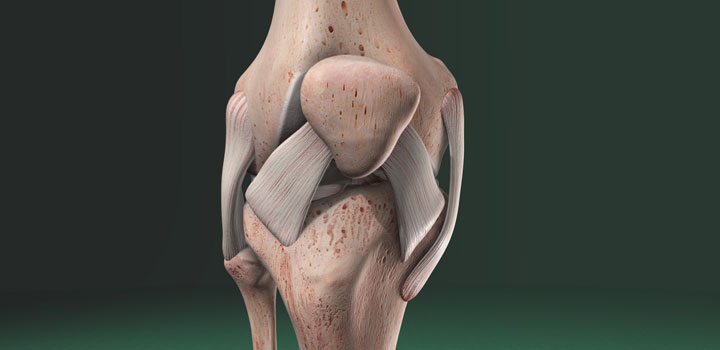Knee Replacement: Surgery
Just Before Surgery
You will not be allowed to drink or eat anything after midnight and on the morning of the surgery. In some cases, you may be allowed to take a medication you normally take in the morning with a minimal amount of water. If instructed to do so, you will need to let the admitting nurse know that you have done this.
When you come into the hospital on the day of surgery, you may have some additional x-rays that might not have been taken previously and have a physical examination by your surgeon or resident.
If you have not already done so, you will be asked to sign an operative consent form to state that you understand what is being proposed and that you are in agreement that we may proceed with the operation. Just prior to surgery, an intravenous line will be started and you will be taken into the operating suite.
Anesthesia
You will be seen by an anesthesiologist on the morning of surgery. The anesthesiologist can answer specific questions you might have. Most of our surgeries are performed under spinal anesthesia. This is a very safe form of anesthesia. It is safer than general anesthesia, which is one of the reasons why we recommend it. Spinal anesthesia disturbs the major body functions a lot less than general anesthesia. Unless there are some specific reasons why a spinal anesthetic should not be used in your case, this is our preferred method of anesthesia.
The anesthesiologist will give you some medication to make you sleepy so that you’re not really aware of what’s going on in the operating room. You will not be totally asleep either. However, the area that will be operated on will be totally numb throughout the operation and for several hours after the surgery.
Total Knee Replacement Surgery
As stated before, the surgery involves the removal of all of the damaged bone and cartilage. This is done with saws and drills much like a carpenter uses. The next step is to prepare the bone for the prosthesis. This involves using specialized tools to make precise cuts and to shape the bone so that the prosthesis will fit properly. The artificial joint is then placed into the bone with or without bone cement.
The surgery itself takes between two to three hours, depending on the complexity of your case. It may depend on how many previous surgeries you’ve had, how badly deformed your knee is, how mobile it is, etc., as to how long it will take. The length of time is not really very important.
Total knee prostheses can be attached to the bone using a material called methylmethacrylate or, more simply, bone cement. With proper technique,this gives an immediate fixation of the prosthesis to the bone.
Another method is called biologic fixation. This method requires that the surface of the prosthesis next to the bone is porous. With time, bone grows into the pores and the prosthesis becomes an integrated part of the joint.
There are advantages and disadvantages to each type of “fixation.” Furthermore, the type of fixation recommended to you will depend on your age, weight, and activity level.
Minimally Invasive Surgery
Over the past 25 years, minimally invasive surgery has revolutionized many fields of medicine. Its key characteristic is the use of specialized techniques and instrumentation that enable the physician to perform major surgery without a large incision. In this respect, MIS Knee Joint Replacement is indeed “minimally invasive,” requiring only a small incision and potentially causing less trauma to the soft tissues.
MIS Total Knee Replacement (TKR)
Unlike conventional TKR, which requires a large incision (8 to 12 inches) and significant disruption of the muscles and tendons, MIS Knee Joint Replacement is performed through a 3 to 4 inch incision. The amount of soft tissue (muscles and tendons, etc.) that is disrupted during surgery may also be reduced compared to conventional techniques. Learn more about minimally-invasive, computer-assisted knee replacement »
MIS Partial Knee Resurfacing (PKR)
Partial Knee Resurfacing (PKR) is a minimally invasive procedure for relieving arthritic knee pain and disability. With PKR, only the damaged surface of the knee joint is resurfaced, potentially minimizing trauma to healthy bone and tissue. PKR implants were developed with patient needs in mind. Because the PKR implants are so much smaller than total knee implants, the surgical incision can be smaller as well. Learn more about minimally-invasive partial knee resurfacing »
Recovery Room
When your surgery is completed, you will go to the recovery room where you will be closely monitored until the effects of the anesthesia and intra-operative medicines are decreased and you are relatively awake and comfortable.
Orthopedic Unit
When you have completed your stay in the recovery room,you will be transferred to your hospital room in the orthopedic nursing unit. You will be lying on your back in a comfortable position. If you have surgery early in the morning, you may sit up on the edge of the bed that evening. In general, all patients are out of bed within twenty-four hours and attending physical and occupational therapy. The therapists will instruct you in learning how to use crutches or a walker and being taught some of the precautions that are necessary in the immediate post-operative period. The physical therapist will answer any of your questions and will go over all of the details.


